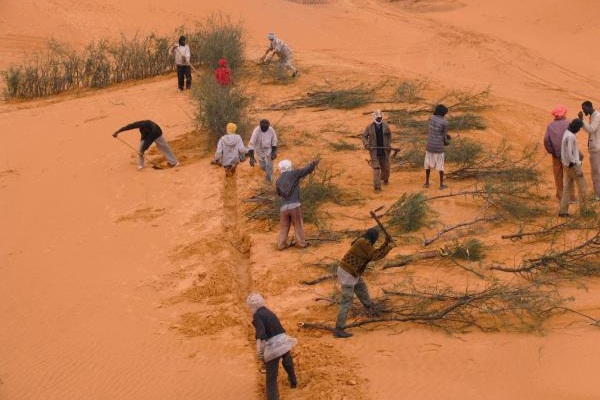Holding back the sand
June 17, 2010, Rome – FAO marks World Day to Combat Desertification today with the publication of a manual that shows how a project in Mauritania successfully fixed dunes and stopped sand encroachment.
It will serve as a useful blueprint for similar projects in Africa. Sand encroachment is what happens when grains of sand are carried by winds and collect in dunes on the coast, along watercourses and on cultivated or uncultivated land.
As the dunes move, they bury villages, roads, oases, crops and irrigation channels and dams, causing major economic damage and increasing poverty and food insecurity.
The right plants
The new FAO publication, Fighting sand encroachment – lessons from Mauritania, compiled with the support of the Walloon region of Belgium and Mauritania’s Ministry of the Environment and Sustainable Development, explains sand encroachment processes and control techniques, with an emphasis on involving local people in sand control activities.
By choosing the right local plant and tree species and involving the local community and national authorities, the FAO Mauritania project fixed 857 hectares of threatened land on the outskirts of the capital city Nouakchott and in southern coastal areas with 400 000 plants grown for the purpose in nurseries.
Two way battle
“The fight against desertification is a fight on two fronts,” said Nora Berrahmouni, FAO Forestry Officer for Arid Zones.
“The first is preventing the process happening in the first place through sustainable management of existing forests, range lands and natural resources.
“The second is repairing the damage done to forests and oases, by first stopping the sand blowing on the degraded soil and then replanting.”
The Support for Rehabilitation and Extension of the Nouakchott Green Belt Project was initiated by His Royal Highness, Prince Laurent of Belgium, financed by a $1.6 million grant from the Walloon Region of Belgium.
It ran for nine years and finished in 2009. It was implemented by FAO in close collaboration with the Government of Mauritania. The project has worked so well that it is now being replicated in other parts of Mauritania.
Brick in a green wall
Lessons will be also drawn up for the Great Green Wall for the Sahara and the Sahel, an initiative being carried out under the auspices of the African Union Commission and the Community of Sahel-Saharan States (CEN-SAD).
The Great Green Wall initiative aims to address the impacts of aridity, low land productivity, desertification and climate change as well as to secure sustainable livelihoods in the Sahara and Sahel drylands.
It will include sustainable management and restoration of degraded forest lands, dune fixation, and management of oases and grazing land across several countries of the Sahara and Sahel, from the Atlantic coast to the Indian Ocean.
FAO, in collaboration with the African Union Commission, has just launched a $460 000 project to kick-start the Great Green Wall project in five selected countries – Chad, Djibouti, Ethiopia, Mali and the Niger. The European Union is also providing 1.4 million euros to implement the initiative in eight other countries.
Lessons learned from this project will also serve the new “inter-regional program for poverty alleviation and combating desertification through collaborative watershed management” launched by FAO in June 2010 in Mauritania, Morocco and Ecuador and funded by Spain.
